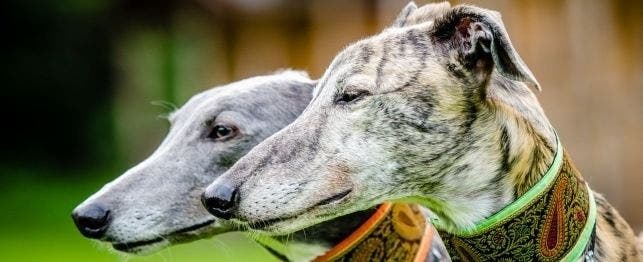
Greyhounds Get a Second Chance
Going on vacation to visit my grandparents in Florida often included a trip to the dog track (or “the dogs” as my grandfather would call it). My grandfather’s company and all the noise and excitement always made it a special day for me. Mostly, I loved watching the sleek canines run like bandits. To me it was a game and I thought of these animals as pets that would – at the end of the day – go home to their respective families to live like my dog did. Never did I think about life for these dogs after their days in the fast lane were over for good.
The Afterlife of a Canine Athlete
According to the Greyhound Rescue Adoption Team, Inc. located in Buffalo, N.Y., there are 49 operating greyhound tracks in 15 states, with Florida having the most. Most tracks keep their greyhounds in kennels where the dogs spend the majority of their off-track life living, eating, breathing, sleeping and being cared for within the kennel walls. Usually dogs are only let out once every 6 hours to relieve themselves and are raced only every third day. According to the New Jersey Greyhound Adoption Program, Inc. (NJ GAP, Inc.), by as early as ages 2 to 5 years, most greyhounds are retired from their athletic activities (usually because they can’t run fast enough) and must be removed from the kennel to make room for a new generation that will follow in their forerunners’ fast footsteps.
If greyhounds aren’t rescued from kennels for adoption by the public, they’re usually euthanized, but some suffer worse fates such as abandonment. According to the Humane Society of the United States (HSUS), 30,000 to 50,000 greyhounds are killed each year.
Greyhounds
Hear Their Story, See their Plight
See this very poignant video about crimes committed against greyhounds
BEWARE: This contains some adult content and graphic abuse images.
A Better Option
Across the country, many organizations have been established to educate the public about this growing greyhound cause and act as liaisons to help facilitate greyhound adoptions. Staff members and volunteers travel to dog tracks to locate retired greyhounds (or they’ll get calls directly from dog track kennels across the country wanting to donate retired dogs) that are healthy and suitable for adoption. Greyhounds are usually then brought to the organization’s home base where they are groomed, spayed, neutered, etc. After successfully completing the adoption application/screening process, for a low fee – which usually includes spaying/neutering, shots and an adoption package – you can adopt a dog in need.
The Greyhound Rescue Adoption Team, Inc. is a non-profit corporation that has been founded to “institute and manage programs for the adoption of retired racing and abandoned greyhounds as family or personal pets.” This organization vows to “educate the general public about the racing environment, the plight of unwanted greyhounds and their suitability as pets.”
The National Greyhound Adoption Program (NGAP) has the only breed/rescue surgical center in the United States. It is 10 1/2 years old. Each year, it performs nearly 1,000 procedures and helps nearly 500 dogs get adopted. Director David Wolf says, “Greyhound adoptions are very successful nationwide because of the dogs; they make wonderful, loving companions and pets.”
Many dog track kennels must “wait in line” to donate dogs to Wolf’s facility. And more and more kennels are constantly calling to see if the NGAP has room for their retired dogs, Wolf says. Increasing “advocacy and pressure,” he adds, are the reasons why increasing numbers of dog tracks are getting with the adoption program. However, it’s very unfortunate that there are still some dog tracks that couldn’t “care less” about saving the lives of retired dogs and opt for euthanasia – or what they consider the easiest way out.
Deserving Dogs
Greyhounds are usually not the high-strung dogs that many people think they are, although they should have lots of exercise and room. According to the NGAP, an adopted greyhound is:
- Eager to please
- Quiet (rarely barks)
- Between 26 to 29 inches tall at the shoulder
- Between 50 to 80 pounds
- Gentle and non-aggressive
- Good-natured with children
- Affectionate and friendly by nature
- Highly intelligent
- Grateful for his new home
- The perfect companionWolf says: “Many greyhound owners experience the potato chip effect; you can’t just have one! Most of all, the lives of those who’ve adopted a greyhound have been enriched beyond what they could have imagined. This is wonderful, because it means we’re doing our job and more people are becoming aware of our cause.”For more information on the breed characteristics of a greyhound – please read Choosing a Greyhound
What You Can Do
Most importantly, get the good word out. You just might have a friend or a friend of a friend looking to adopt a dog. Why not suggest a greyhound in need? Also, many states have greyhound rescue/adoption programs and would welcome volunteers, foster parents and/or adopters. If interested, don’t delay and check in your area today.
Contact Information
National Greyhound Adoption Program (NGAP)
8301 Torresdale Avenue
Philadelphia, PA 19136
(800) 348-2517
(215) 331-1947 (in Pennsylvania)
www.ngap.org\ Email: ngap@ix.netcom.com
Greyhound Rescue Adoption Team, Inc.
(716) 839-4275
www.greathounds.org
New Jersey Greyhound Adoption Program, Inc. (NJ GAP, Inc.)
NJ GAP, Inc.
335 County Road 513
Califon, NJ 07830-4164
(908) 832-9678
www.njgreyhounds.org\ Email: info@njgreyhounds.org.